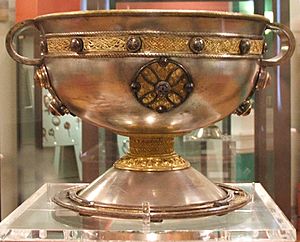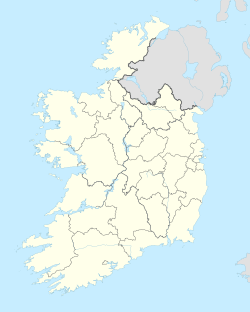Ardagh Fort facts for kids
|
Lios Ardach
|
|

The Ardagh Chalice, buried at Ardagh Fort c. 1740
|
|
| Alternative name | Reerasta Rath, Ravenstar Fort, Ardagh Ringfort |
|---|---|
| Location | Reerasta South, Ardagh, County Limerick, Ireland |
| Region | Shannon Valley |
| Coordinates | 52°29′37″N 9°04′05″W / 52.493580°N 9.068153°W |
| Altitude | 103 m (338 ft) |
| Type | ringfort |
| Diameter | 62 m (203 ft) |
| History | |
| Material | earth |
| Founded | 1000 BC |
| Periods | Bronze/Iron Age |
| Cultures | Gaelic Ireland |
| Site notes | |
| Ownership | State |
| Official name | Ardagh Ringfort |
| Reference no. | 459 |
Ardagh Fort is an ancient circular earthwork, also known as a ringfort, located in County Limerick, Ireland. It's a very important historical site because of a famous treasure found there, called the Ardagh Hoard. This hoard includes a beautiful silver and gold cup, known as the Ardagh Chalice. The fort is also a National Monument, meaning it's protected by the government.
Contents
Where is Ardagh Fort?
Ardagh Fort sits on top of a hill near the village of Ardagh. It's about 103 meters (338 feet) above sea level. From the fort, you can look out over the Daar River.
What is the History of Ardagh Fort?
How Old is the Fort?
Ardagh Fort is very old! It was built around 1000 BC. This means it dates back to the late Bronze Age or early Iron Age. People from Gaelic Ireland lived here during those times.
The Discovery of the Ardagh Hoard
In September 1868, two local boys, Jimmy Quin and Paddy Flanagan, were digging for potatoes. They were working at the edge of the fort. Farmers sometimes avoided forts because they believed fairies lived there. However, these boys might have chosen the spot hoping it would protect their crops from a plant disease called potato blight.
While digging, they found something amazing: the Ardagh Hoard! This treasure included a stunning silver and gold chalice (a special cup), a copper-alloy cup, and four brooches. These items were made a long, long time ago, between the 8th and 9th centuries AD.
Why Was the Treasure Buried?
The hoard also contained a wooden cross from the Penal era. This was a time in Irish history (around the 1700s) when certain religious practices were restricted. The cross had the number "727" carved on it, which likely meant "1727". It's thought that the treasure was hidden around 1740 to keep it safe during these difficult times. People even say that Catholic Mass was secretly held at the fort during the Penal era.
What Does Ardagh Fort Look Like?
Ardagh Fort is a type of ringfort called a "rath." It has a tall bank and a deep ditch around it on the north and south sides. The east and west sides were never fully built up. The fort covers an area of about 0.3 hectares (three-quarters of an acre).


